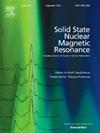使用CPMAS CryoProbe和中等磁场进行高质量13c检测淀粉样蛋白样品的结构分析
IF 2.4
3区 化学
Q4 CHEMISTRY, PHYSICAL
引用次数: 0
摘要
生物分子的固态核磁共振(SSNMR)通常需要几毫克的样品才能达到多维实验的足够灵敏度,特别是在依赖13C检测时。快速魔角纺丝(MAS)和1H检测方法的最新发展使亚毫克样品在小直径转子中的使用成为可能,但这些方法需要先进的硬件,并且经常受到有限的1H化学位移色散的影响。在这里,我们证明了CPMAS CryoProbe能够从标准3.2 mm转子中包装的均匀标记的淀粉样蛋白原纤维中获取高质量的13c检测的2D和3D光谱。作为概念验证,我们将这种方法应用于RIPK3, RIPK3是免疫信号中形成功能性淀粉样蛋白组装的关键蛋白。使用标准的三维实验(NCACX和NCOCX),我们获得了13C和15N骨架分配和二级结构信息,尽管样品数量有限,仅使用适度的磁场。这些发现突出了CPMAS CryoProbes在质量有限的SSNMR研究中改变范式的潜力,从完全依赖1h检测和快速MAS到重新采用13c检测策略。本文章由计算机程序翻译,如有差异,请以英文原文为准。

High-quality 13C-detected structural analysis of mass-limited amyloid samples using a CPMAS CryoProbe and moderate magnetic fields
Solid-state NMR (SSNMR) of biomolecules typically requires several milligrams of sample to achieve sufficient sensitivity for multidimensional experiments, especially when relying on 13C detection. Recent developments in fast magic-angle spinning (MAS) and 1H-detected methods have enabled the use of submilligram samples in reduced-diameter rotors, but these approaches demand advanced hardware and often suffer from limited 1H chemical shift dispersion. Here, we demonstrate that a CPMAS CryoProbe enables the acquisition of high-quality 13C-detected 2D and 3D spectra from just ∼1.5 mg of uniformly labeled amyloid fibrils packed in a standard 3.2 mm rotor. As a proof of concept, we apply this approach to RIPK3, a key protein in immune signaling that forms functional amyloid assemblies. Using standard 3D experiments (NCACX and NCOCX), we obtain 13C and 15N backbone assignments and secondary structure information, despite the limited sample quantity and the use of only moderate magnetic fields. These findings highlight the potential of CPMAS CryoProbes to shift the paradigm in mass-limited SSNMR studies, from relying exclusively on 1H-detection and fast MAS to reembracing 13C-detected strategies.
求助全文
通过发布文献求助,成功后即可免费获取论文全文。
去求助
来源期刊
CiteScore
5.30
自引率
9.40%
发文量
42
审稿时长
72 days
期刊介绍:
The journal Solid State Nuclear Magnetic Resonance publishes original manuscripts of high scientific quality dealing with all experimental and theoretical aspects of solid state NMR. This includes advances in instrumentation, development of new experimental techniques and methodology, new theoretical insights, new data processing and simulation methods, and original applications of established or novel methods to scientific problems.

 求助内容:
求助内容: 应助结果提醒方式:
应助结果提醒方式:


